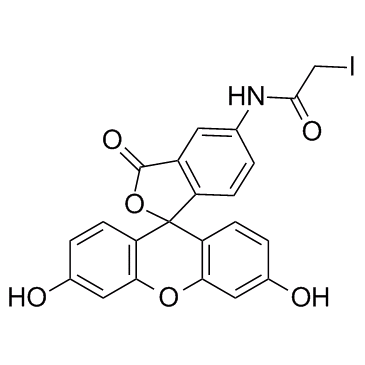5-(Iodoacetamido)fluorescein

5-(Iodoacetamido)fluorescein structure
|
Common Name | 5-(Iodoacetamido)fluorescein | ||
|---|---|---|---|---|
| CAS Number | 63368-54-7 | Molecular Weight | 515.25400 | |
| Density | 1.95 g/cm3 | Boiling Point | 788.4ºC at 760 mmHg | |
| Molecular Formula | C22H14INO6 | Melting Point | 265-267ºC (dec.)(lit.) | |
| MSDS | Chinese USA | Flash Point | 430.6ºC | |
Use of 5-(Iodoacetamido)fluorescein5-IAF is an idoacetamide derivate of fluoresceine. |
| Name | 5-(Iodoacetamido)fluorescein |
|---|---|
| Synonym | More Synonyms |
| Description | 5-IAF is an idoacetamide derivate of fluoresceine. |
|---|---|
| Related Catalog | |
| In Vitro | 8 µM GSH sample solution is derivatized with 8, 80, 200, 400, 800, 1600, 2000, 2500 µM 5-IAF, respectively and analyzed with CE-LIF. The highest signal intensity is obtained with 400 and 800 µM 5-IAF[2]. |
| Kinase Assay | HepG2 cells are lysed in 1 mL 2% acetonitrile in water, and transfered to a 1.5 mL centrifuge tube. An additional 200 µL 2% acetonitrile is used to rinse the dish and combined with the cell extract. To measure the free GSH concentration, three aliquots of 80 µL cell extract are immediately transferred to 0.5 mL centrifuge tubes after a quick mix. Then 20 µL 50 µM NAC is added, followed by the addition of 100 µL 400 µM 5-IAF to the mixture. The derivatization is conducted at room temperature in dark for 1 h, after which the mixtures are centrifuged at 9000× g for 5 min to sediment the insoluble proteins. 10 µL supernatant is diluted 100× with water and analyzed immediately by CE-LIF[2]. |
| References |
| Density | 1.95 g/cm3 |
|---|---|
| Boiling Point | 788.4ºC at 760 mmHg |
| Melting Point | 265-267ºC (dec.)(lit.) |
| Molecular Formula | C22H14INO6 |
| Molecular Weight | 515.25400 |
| Flash Point | 430.6ºC |
| Exact Mass | 514.98700 |
| PSA | 116.84000 |
| LogP | 4.41510 |
| Index of Refraction | 1.781 |
| Personal Protective Equipment | Eyeshields;Gloves;type N95 (US);type P1 (EN143) respirator filter |
|---|---|
| Safety Phrases | 22-24/25 |
| RIDADR | NONH for all modes of transport |
|
Combination of direct infusion mass spectrometry and gas chromatography mass spectrometry for toxicometabolomic study of red blood cells and serum of mice Mus musculus after mercury exposure.
J. Chromatogr. B. Analyt. Technol. Biomed. Life Sci. 985 , 75-84, (2015) Although mercury (Hg) is an important environmental and occupational pollutant, its toxicological effects, especially in serum and red blood cells (RBCs), have been scarcely studied. A toxicometabolom... |
|
|
Optical control of protein-protein interactions via blue light-induced domain swapping.
Biochemistry 53(30) , 5008-16, (2014) The design of new optogenetic tools for controlling protein function would be facilitated by the development of protein scaffolds that undergo large, well-defined structural changes upon exposure to l... |
|
|
Redox signalling to nuclear regulatory proteins by reactive oxygen species contributes to oestrogen-induced growth of breast cancer cells.
Br. J. Cancer 112 , 1687-702, (2015) 17β-Oestradiol (E2)-induced reactive oxygen species (ROS) have been implicated in regulating the growth of breast cancer cells. However, the underlying mechanism of this is not clear. Here we show how... |
| N-(3',6'-dihydroxy-3-oxospiro[2-benzofuran-1,9'-xanthene]-5-yl)-2-iodoacetamide |
| 4(5)-(Iodoacetamido)fluorescein |

